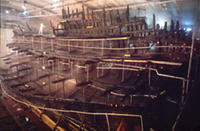Preserving a 460 year old wreck
 | An international team of researchers has analysed the sulphur and iron composition in the wooden timbers of the Mary Rose, an English warship wrecked in 1545, which was salvaged two decades ago. |
The Mary Rose served as English King Henry VIII's principal warship for 35 years until she went down outside of Portsmouth in 1545. In 1982 the hull was recovered from the sea and is currently undergoing a conservation process. The first author of the publication, Magnus Sandström, and his colleagues showed recently that the accumulation of sulphur within shipwrecks preserved in seawater is common by studying the Swedish warship Vasa, which remained on the seabed for 333 years. Their research concluded that sulphur in contact with oxygen could pose conservation problems. Over time, sulphur can convert to sulphuric acid, which slowly degrades the wood until the hull's stability is lost.
The authors examined the Mary Rose to determine the potential threat and found about 2 tons of sulphur in different compounds rather uniformly distributed within the 280-ton hull. To determine the sulphur species present in the wood, researchers first carried out experiments at SSRL. The team needed to obtain complimentary information in order to know the precise location of sulphur species at the micron scale and they then came to the ESRF. By studying thin wood slices perpendicularly cut to the cell walls at X-ray microscopy beamline ID21, they found high concentrations of organo-sulphur compounds in the lignin-rich areas between the cells, which may have helped preserve the ship while it was submerged in the seawater. This helped to understand how accessible and reactive the different sulphur compounds found are to acid-producing oxidation.
Plenty of iron and pyrite is also present in the Mary Rose, which is a concern, since in the moist wood iron ions can catalyse the conversion of sulphur to sulphuric acid in the presence of oxygen. The authors suggest that chemical treatments to remove or stabilize the remaining iron and sulphur compounds, and reducing humidity and oxygen access, are requirements for long-term preservation.
At the Mary Rose Trust they are already investigating new treatments to prevent new acid formation. For slowing down the organo-sulphur oxidation reaction and prevent new acid formation, wood samples from the Mary Rose are being treated with antioxidants in combination with low and high grade polyethylene glycol (PEG). Another approach to slow down acid formation in PEG treated conserved archaeological wood is to maintain it in a stable climate. It is hoped that keeping a constant low humidity of 50-55% without variations of temperature will stop changes in sulphur speciation. To maintain a stable microclimate within the wood structure a surface coating offers a possible solution, although the effectiveness of this approach has yet to be tested. “This ongoing research is considered to be an important step forward in devising improvements to the current Mary Rose hull treatment programme”, explains Mark Jones, curator of the Mary Rose. ###
Reference: Magnus Sandström, Farideh Jalilehvand, Emiliana Damian, Yvonne Fors, Ulrik Gelius, Mark Jones and Murielle Salomé. Sulphur accumulation in the timbers of King Henry VIII's warship Mary Rose: a pathway in the sulphur cycle of conservation concern, PNAS, Proc. Natl. Acad. Sci. USA published 26 September 2005, 10.1073/pnas.0504490102.
This press release is also available in Spanish and French.
Contact: Montserrat Capellas press@esrf.fr +33-476-88-26-63 European Synchrotron Radiation Facility
more at science and Mary Rose or England and Archaeological or Archaeology and ships











No comments:
Post a Comment